Scientific name: Forsythia species, Forsythia x intermedia
Suggested pronunciation: for-SITH-ee-aa in-ter-MEE-dee-uh
Common names: Forsythia, golden bell, Easter tree
Family: Oleaceae – olive (suggested pronunciation: oh-lee-AY-see-ee)
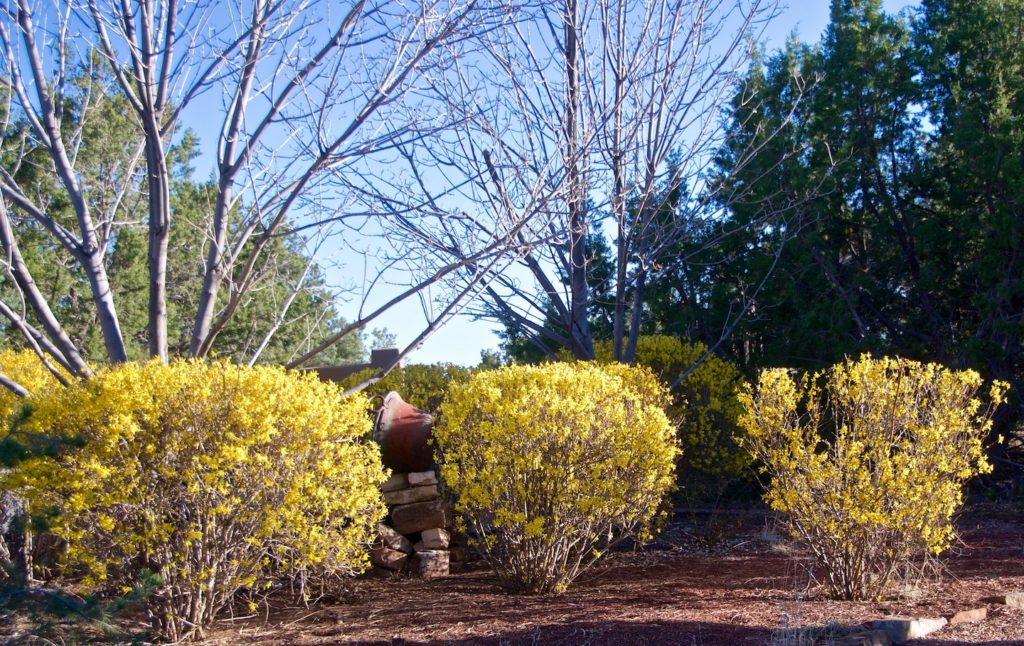
Forsythia in bloom. Photo by Janice Tucker.
USDA Plant Zones 5-8
Text by Janice Tucker
Photos by Janice Tucker and University of Minnesota Extension
Most spring flowers arrive on tiptoe. New shoots send out tender, green foliage, teasing us until they finally unfold their colorful blossoms. But the Forsythia reverses the progression of “leaves first, flowers later”. It seems to share our impatience for blooming color to relieve the winter doldrums. It arrives with a blast of sensational yellow flowers that cover every inch of the branches, proclaiming in no uncertain terms that spring is here!
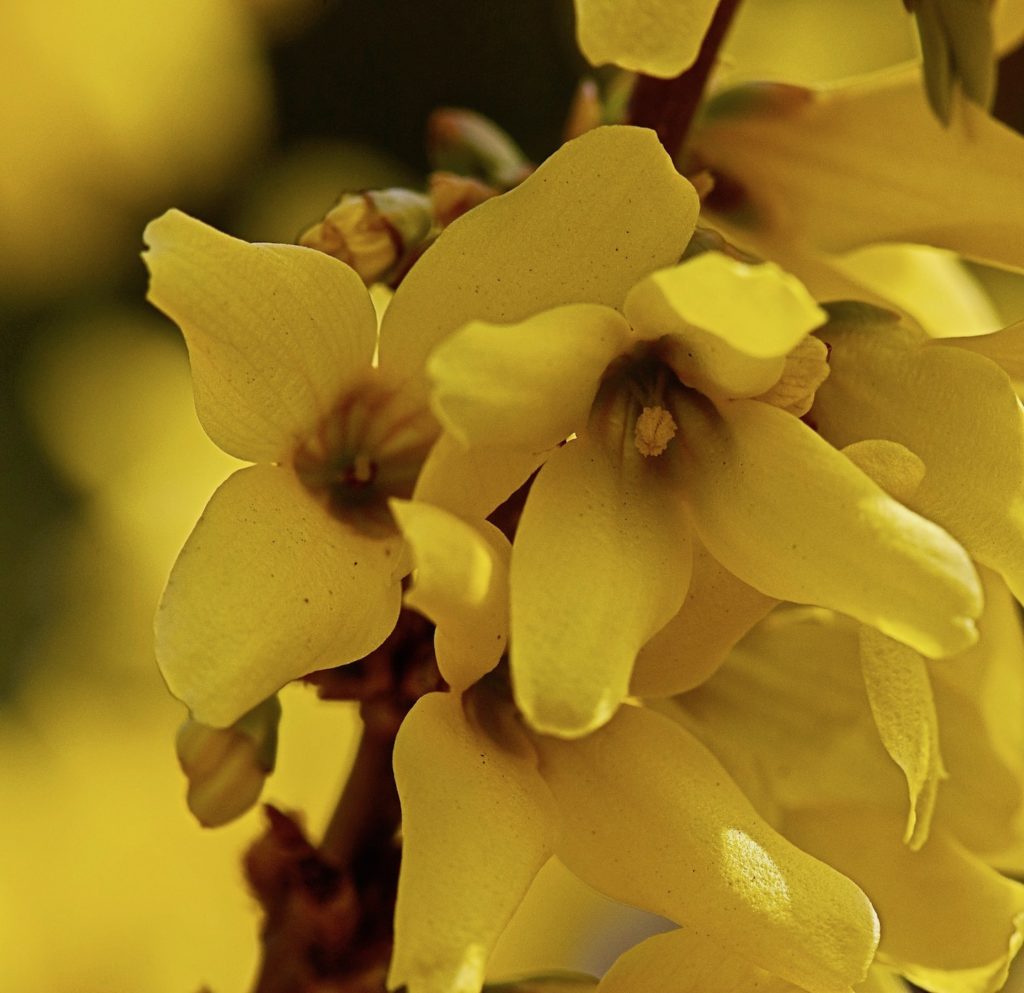
Forsythia close up of flowers. Photo by Janice Tucker.
A member of the olive family (Oleaceae), the Forsythia consists of eleven species, ten of which are native to east Asia. The exception is a species indigenous to the Balkan Peninsula in southeastern Europe. Over the years they have been introduced into many other parts of the world. Hybrids and cultivars have further increased their current availability to plant aficionados. The hybrid, Forsythia × intermedia, and its cultivars are among the most successful specimens and is a Santa Fe spring favorite. This large shrub is impossible to ignore when it awakens from dormancy in March and April. The branches come to life, cloaked in what must surely be captured sunlight masquerading as brilliant yellow flowers. Its visibility is further enhanced when surrounded by a sleepy landscape that is a step or two behind in its response to the call of spring. Alas, the dramatic floral display is ephemeral. After about a month or so the flowers fade, giving way to pretty green leaves, which provide a handsome backdrop for neighboring summer and fall flowering plants. As the temperatures turn colder and the days grow shorter, the leaves disappear, leaving a skeletal form to blend into the winter landscape.
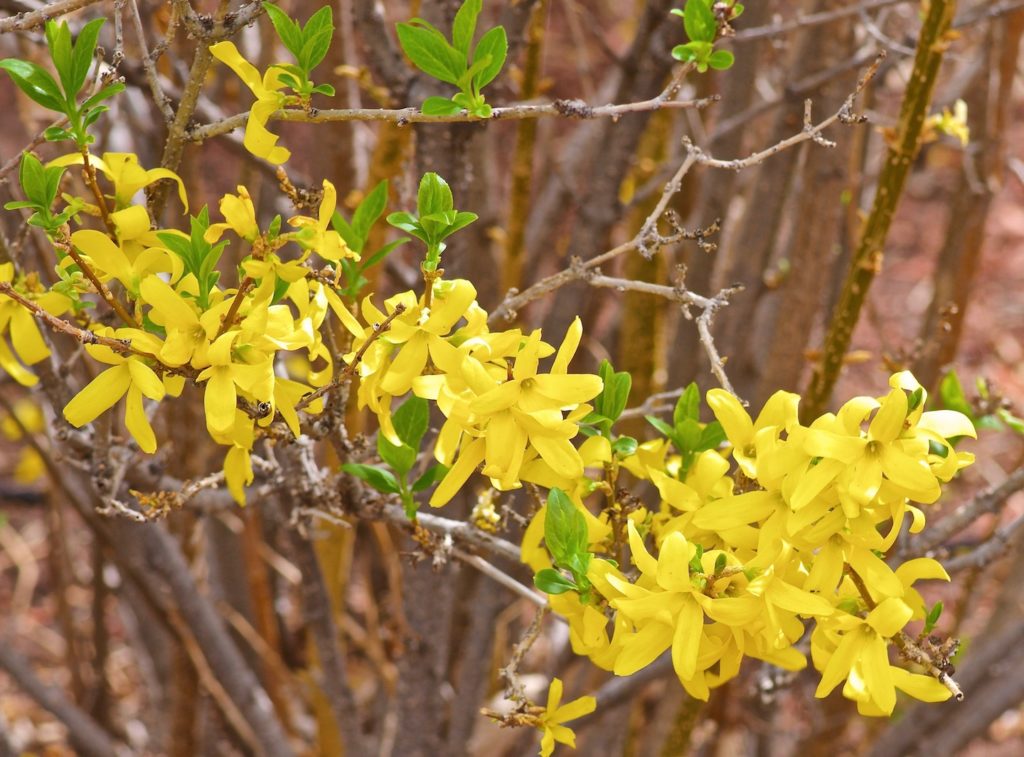
Forsythia flowers. Photo by Janice Tucker.
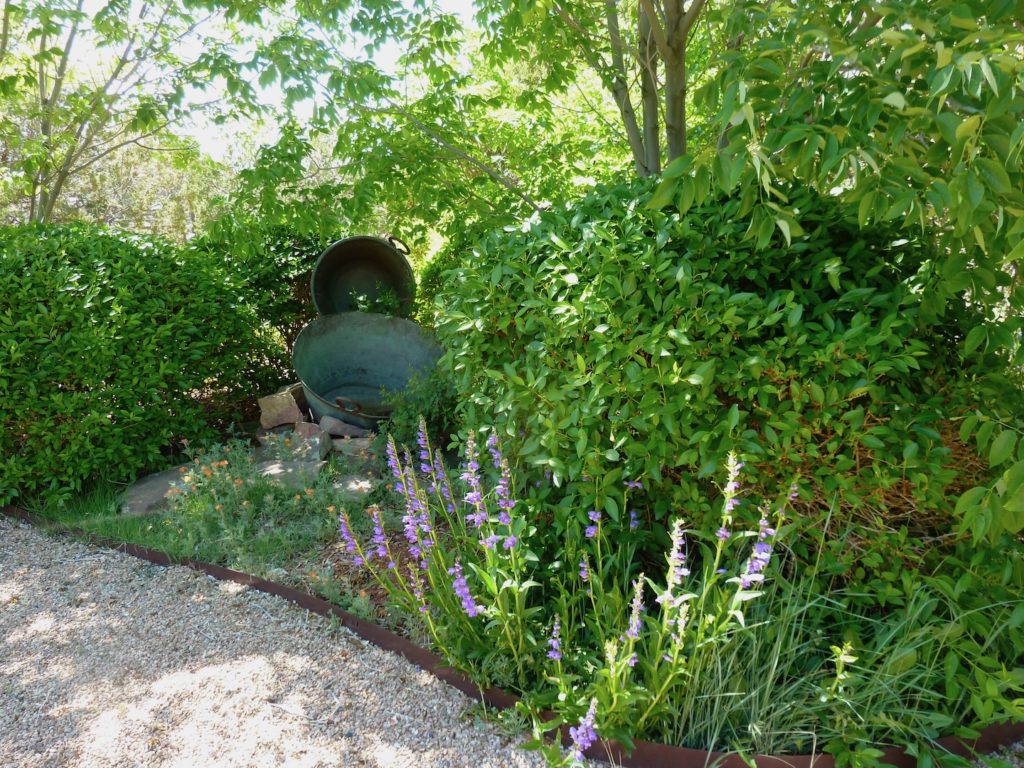
Forsythia backdrop for summer wildflowers. Photo by Janice Tucker.
This deciduous perennial naturally forms a symmetrical, fan-shaped growth habit. It is a fast-growing shrub that usually tops out at a height and spread of six feet but can reach up to nine feet. In March or April, an abundance of yellow, bisexual flowers with four petals fused near the throat are lined along upright branches from base to tip. Opposite, ovate leaves appear before the flowers completely fade, resulting in a smooth transition from flowers to foliage. Forsythia not only blooms early but is also one of the last plants to drop its foliage in the winter. Propagation is facilitated by winged seeds propelled by the wind. It is a larvae host of the brown-tail (Euproctis chrysorrhoea) and Gothic (Naenia typica) moths. As the main pollinator, bees teem around a banquet of lovely flowers to sip the tasty nectar.
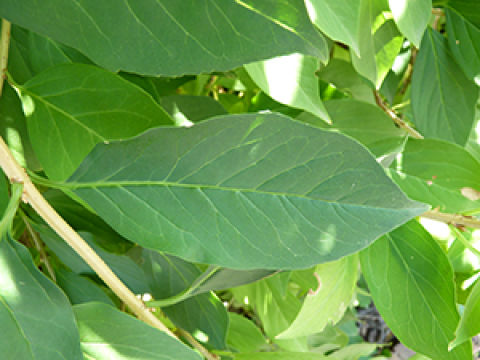
Forsythia leaves. Courtesy of University of Minnesota https://extension.umn.edu/trees-and-shrubs/forsythia
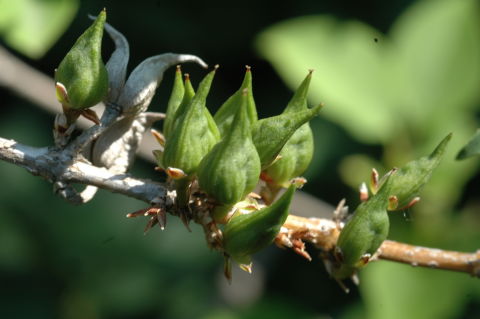
Forsythia seed capsules. Courtesy of University of Minnesota https://extension.umn.edu/trees-and-shrubs/forsythia
Choosing a sunny or partly sunny location helps to ensure abundant flower production. Loose soil that drains well is a must. After the plant is established, water requirements are minimum to moderate. Pruning is not absolutely necessary but an annual nip and clip are highly recommended. Flowers grow on the previous year’s growth. Therefore, it is very important to prune shortly after the flowers are spent to avoid inadvertently cutting off new growth that will produce the following year’s flower buds. Pruning too late, such as waiting until June or July, will result in no amazing flower show the following spring. And that amazing flower show is the major reason for choosing this shrub in the first place. It makes an attractive hedge when several are grouped in the same area. It can be shaped into a compact form that complements a more formal outdoor setting. Some varieties are prone to sending out suckers. Keep that in mind if the goal is to contain the growth within established borders. Cultivars have been successfully propagated by root stem cuttings. In the dead of winter when flowers in the garden seem like a distant memory, place a few cut branches in water. In a week or so, yellow flowers will bloom to brighten a cold, overcast, winter day.
The F. x intermedia, is a hybrid of the F. suspensa and F. viridissima. (The intermedia species indicates the plant is a hybrid.) The ‘Lynwood’ cultivar, a branch sport of the F. x intermedia ‘Spectabilis’, was granted the Royal Horticulture Society’s Award of Garden Merit and is one of the cultivars that does well in Santa Fe’s USDA Zone 6b. Because the F. x intermedia is a hybrid that has undergone many repeated crosses, its offspring is often variable, sometimes favoring the characteristics of one parent plant over the other.
Since Forsythia has graced east Asian gardens for many centuries, it would take more than a paragraph to cover its complete saga. Therefore, only a brief account of the name and its introduction to the western world follows: Swedish botanist-physician Carl Peter Thunberg (1743-1828) – an apostle of the famed Carl Linnaeus (1707-1778) – is believed to be the first westerner to notice a Forsythia growing in a Japanese garden. However, he misidentified it as a lilac (Syringa), giving it the full name of Syringa suspensa. Some time later another follower of Carl Linnaeus, Danish-Norwegian botanist-physician Martin Henrichsen Vahl (1749-1804), determined the plant did not exhibit the characteristics of a lilac and reclassified it in the genus, Forsythia. He retained the specific, suspensa, which refers to the plant’s hanging growth habit. Vahl named the genus in honor of William Forsyth (1737-1804), a Scottish botanist and a founder of the Royal Horticultural Society. In 1833 Scottish botanist and plant hunter, Robert Fortune (1812-1880), shipped the plant along with other collections to Holland and is credited with introducing the Forsythia to Europe. Over the ensuing years other plant collectors exploring east Asian flora brought additional species to Europe and the rest of the world. It is fascinating to delve into the history of the arduous and often perilous botanical pursuits of the intrepid 18th and 19th century plant collectors. But those stories are for another time.
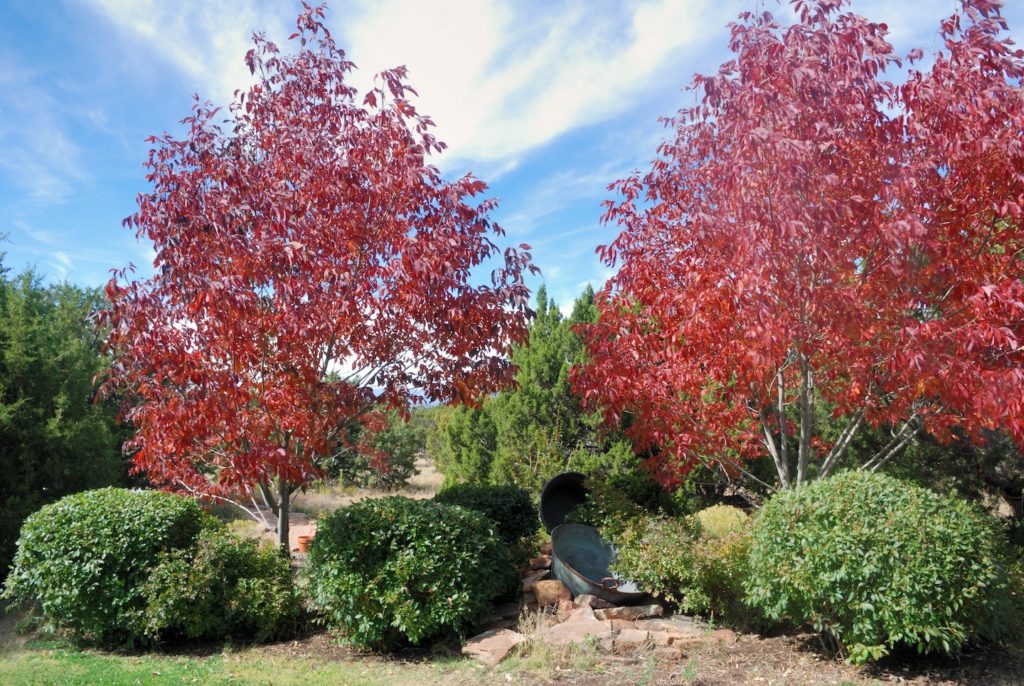
Ash Trees and Forsythia in fall. Photo by Janice Tucker.
The most used common name is also the generic, Forsythia. The vernacular, golden bells, describes the drooping bell shape of the flowers after a rain. It is also known as the Easter tree, which signifies the early blooming time that often coincides with the Easter holy days.
Although not a native plant to our part of the world, the Forsythia has won the hearts of many gardeners in the Santa Fe area. Its beauty and proud history can be summed up in the words of U. S. Poet Laureate,
Billy Collins (1941 – ):
“I begin to think about the long chronicle of forsythia
how these same flowers have blazed
through the centuries,
roused from the ground by the churning spring…”
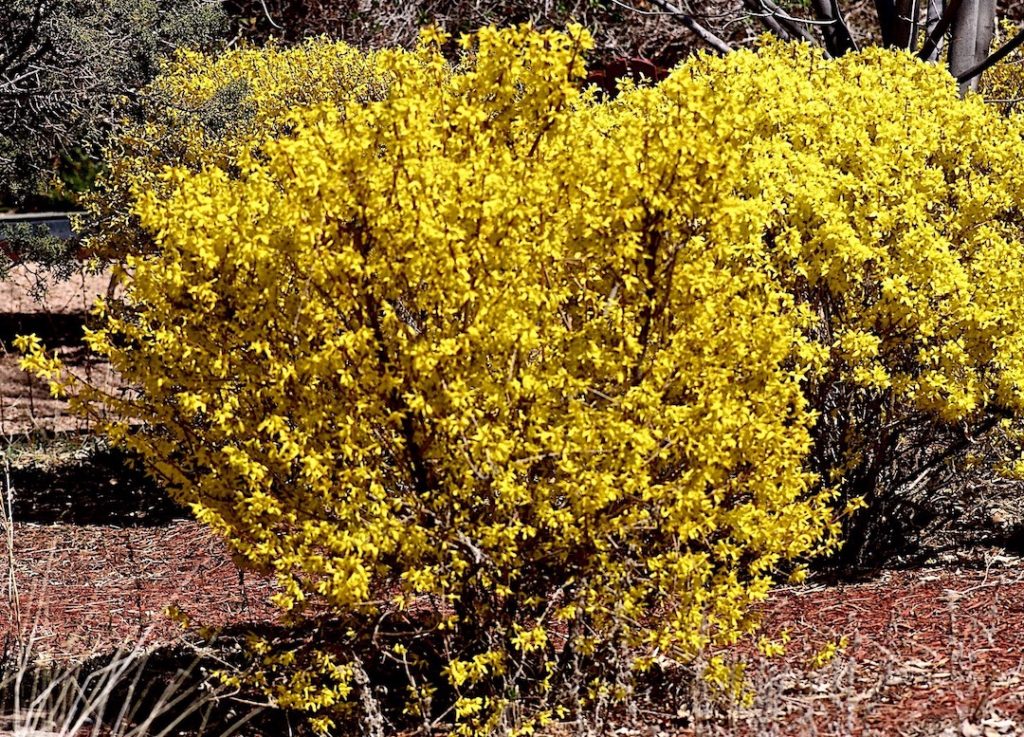
Forsythia full plant. Photo by Janice Tucker.
Many thanks to Helen Woody and Jeanne Gozigian for proofreading this article.
Sources Consulted:
“Billy Collins”, Poets.org.Web.19 Feb. 2020. Retrieved from: https://poets.org/poet/billy-collins.
“Carl Linnaeus”. Berkeley University of California Department of Paleontology. Web.16 Feb. 2020. Retrieved from: https://ucmp.berkeley.edu/history/linnaeus.html.
“Carl Peter Thunberg”. Wikipedia. 12 Jan. 2020. Web.15 Feb. 2020. Retrieved from: https://en.wikipedia.org/wiki/Carl_Peter_Thunberg.
Deane, Green. “Forsythia”. Eat The Weeds. 2018. Web.16 Feb. 2020. Retrieved from: http://www.eattheweeds.com/foraging-for-forsythia-2/.
“Forsythia” New World Encyclopedia. 19 Apr. 2019. Web.16 Feb. 2020. Retrieved from: https://www.newworldencyclopedia.org/entry/Forsythia.
“Forsythia x intermedia ‘Lynwood Variety’ ”. Plant Finder. Missouri Botanical Garden. Web.10 Feb. 2020. Retrieved from: http://www.missouribotanicalgarden.org/PlantFinder/PlantFinderDetails.aspx?taxonid=269583&isprofile=0&gen=Forsythia.
“Forsythia”. University of Minnesota Extension. 2019. Web.11 Feb. 2020. Retrieved from: https://extension.umn.edu/trees-and-shrubs/forsythia.
“Forsythia”. Wikipedia. Web. 30 Jan. 2020.19 Jan. 2020. Retrieved from: https://en.wikipedia.org/wiki/Forsythia.
Gorman, Jim. “Forsythia”. Mount Auburn Cemetery. Web. 2020.18 Feb. 2020. Retrieved from: https://mountauburn.org/horticulture-highlight-forsythia/.
“Martin Vahl.” People Pill. Web.12 Feb. 2020. Retrieved from: https://peoplepill.com/people/martin-vahl/.
“Martin Vahl”. Wikipedia. 10 Feb. 2020. Web.12 Feb. 2020. Retrieved from: https://en.wikipedia.org/wiki/Martin_Vahl.
“Oleaceae”. Plant Facts. Ohio State University. Web. 2002. 21 Dec. 2019. Retrieved from: https://plantfacts.osu.edu/resources/hcs300/olea.htm /.
“Robert Fortune”. Plant explorers.com. Web. 1999-2020. 22 Feb 2020. Retrieved from: https://www.plantexplorers.com/explorers/biographies/fortune/robert-fortune.htm.
“William Forsyth (horticulturist)”. Wikipedia. 25 Aug. 2019. Web. 15 Feb. 2020. Retrieved from: https://en.wikipedia.org/wiki/William_Forsyth_(horticulturist).


